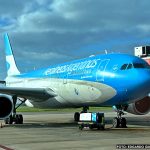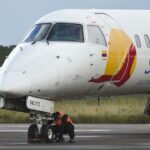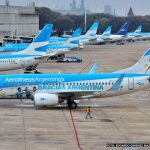This Wednesday, November 6, the first commercial flights of Airbus’s latest jet, certified by European authorities, began: the A321XLR.
The long-range aircraft derived from the A321neo completed its first flight between Madrid and Paris, taking off at 8:18 local time and landing in France at 9:55, in a commercial service that served as training for the crew and other employees in the operation of this jet, which was created with the goal of revolutionizing the market. The plane was delivered on October 30 and registered as EC-OIL.
The flight, lasting just over 2 hours, was only a fraction of what the A321XLR will cover for Iberia in the transatlantic flights that will soon begin between the Spanish capital and the U.S. East Coast, as reported by our affiliate, Aeroin.
This debut is scheduled for November 14, according to the latest schedule released by Iberia. On that day, the A321 XLR will take off from Madrid and fly for 8 hours and 25 minutes before landing in Boston, Massachusetts. Washington/Dulles will follow on January 15.
Unlike the 240 seats that A321neo jets typically carry on domestic or intra-European routes, Iberia’s A321XLR is configured with 182 seats, 14 of which are lie-flat seats in Business Class, with the rest in Economy Class with increased seat spacing. According to Airbus’s order book, Iberia has ordered eight A321XLRs, although airlines in the International Airlines Group (IAG) hold options for an additional fourteen aircraft.
This smaller seating capacity, along with additional fuel tanks in the aircraft’s hold, enables extended range, replacing the Boeing 757-200 on lower-demand intercontinental flights. It is expected that next year, the A321XLR will begin operations in Brazil with Iberia, flying from Madrid to northeastern cities like Salvador, Natal, and Recife.
The Airbus A321XLR, a highly anticipated delivery
The Airbus A321XLR, an evolution of the successful A321neo, received its certification in July 2024, following its first flight in 2022. Since the beginning of the year, it has undergone intensive testing under the supervision of the European Union Aviation Safety Agency (EASA), evaluating the functionality and reliability of its systems.
However, since mid-2024, the manufacturer has been facing challenges with the aircraft’s anticipated range. The adjustment is the result of agreements with European regulators concerning necessary design safeguards, an essential step to achieve certification of the new long-range single-aisle aircraft, primarily related to the additional fuel tank. This situation delayed the delivery of the first model, initially expected in the first half of 2024.
The Airbus A321XLR stands out for its extended range capability, thanks to a central rear tank that holds up to 12,900 liters of fuel. With the additional central tank, this model can reach up to 4,700 nautical miles (8,700 kilometers) or 11 hours of nonstop flight. Additionally, successful results have been achieved with sustainable aviation fuel (SAF), with the goal of certifying it to operate with 100% SAF by 2030.
The manufacturer has received orders for 550 aircraft from airlines such as Iberia, United Airlines, American Airlines, and South American carriers like jetSMART, SKY Airline, and LATAM. Most airlines plan to replace the Boeing 757 and wide-body aircraft with the XLR, as well as add secondary routes with this model.
Other airlines that have confirmed their first flights with the XLR include Aer Lingus and Wizz Air for 2025.














